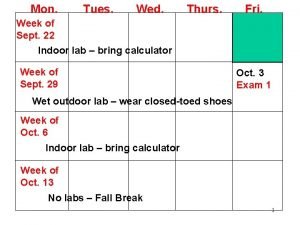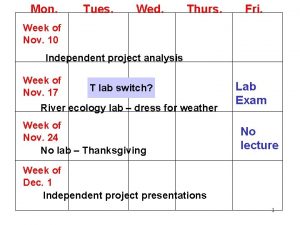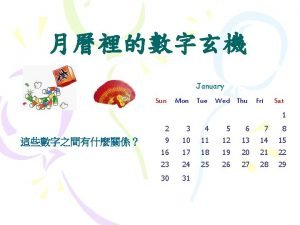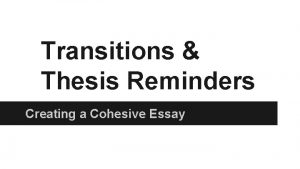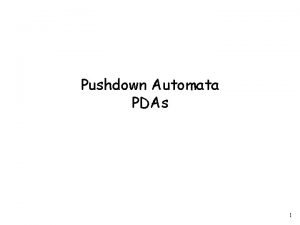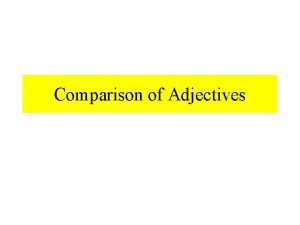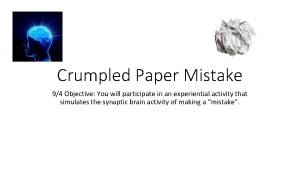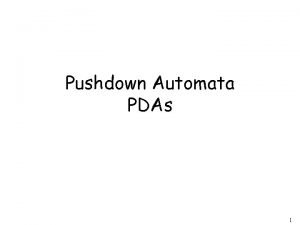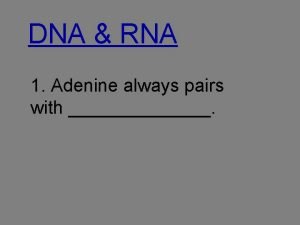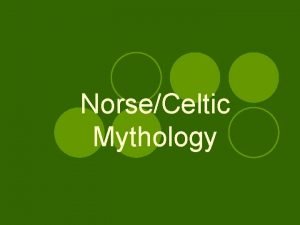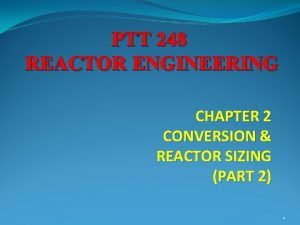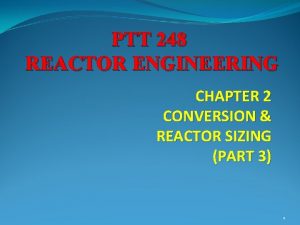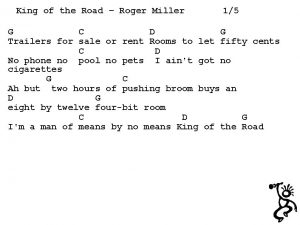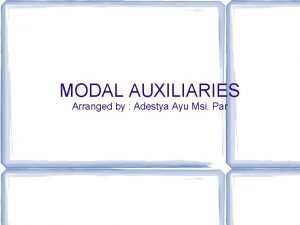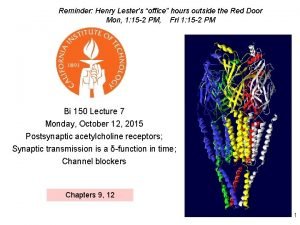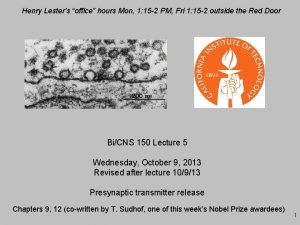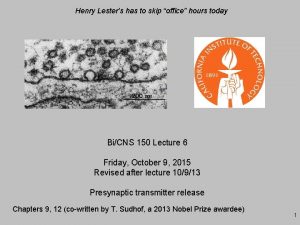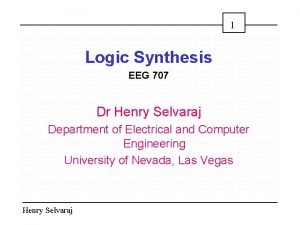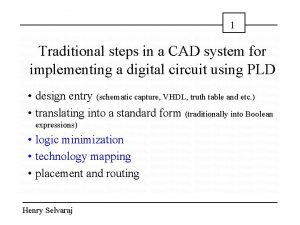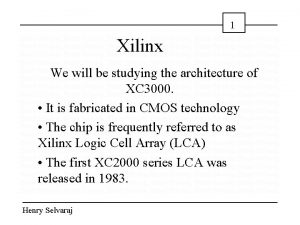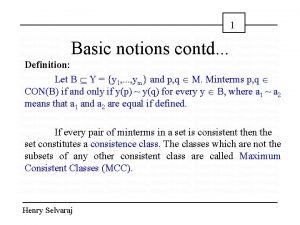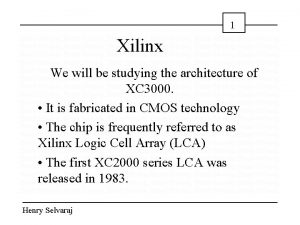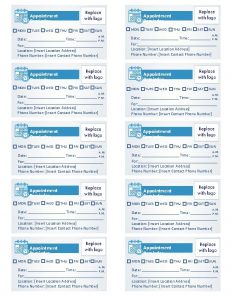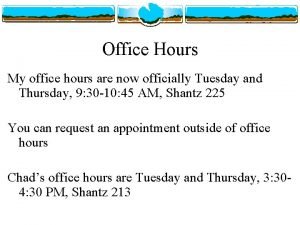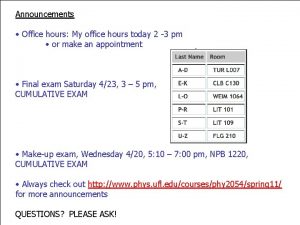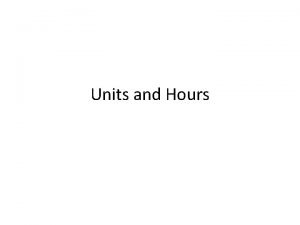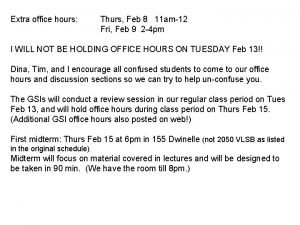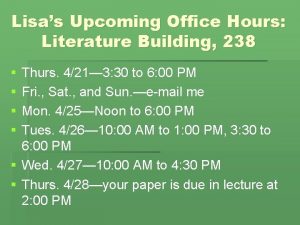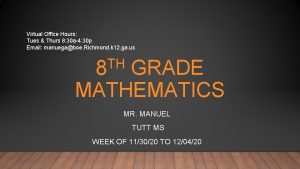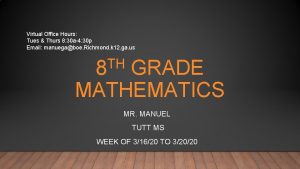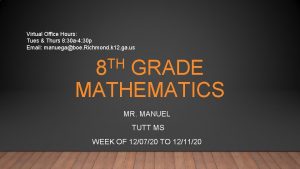Reminder Henry Lesters office hours Mon Thurs 1
















































- Slides: 48

Reminder: Henry Lester’s “office” hours Mon, Thurs 1 -1: 30 PM, outside the Red Door Bi 1 Lecture 9 Thursday, April 13, 2006 Synapses: Biophysical Machines 1

Video on synaptic transmission 2

Narrated by Leonard Nemoy 3

Cerebral cortex Axons Dendrites Synapses Synaptic vesicles (volleyballs), mitochondria (watermelons) 1. Movements do not occur in 1 ms; vesicles are already “docked”. 2. Neurotransmitter diffuses across the synaptic cleft in a few ms 3. There is little space between neurons 4. “Slight” errors cause mental illness? Unproven! (But single-codon mutations do cause some neuroscience diseases) 4

from Lecture 4 Parts of two neurons Postsynaptic neuron Presynaptic neuron Excitatory Inhibitory terminal Greek, “axis” presynaptic terminal axon dendrites Greek, “tree” cell body nucleus presynaptic terminal synaptic cleft direction of information flow postsynaptic dendrite Nestler Figure 2 -2 (rotated) 5

from Lecture 4 The synapse is a point of information processing Greek, “connection, junction” presynaptic neuron postsynaptic neuron Nestler Box 2 -3 Figure A An adult human brain contains ~ 1011 neurons, and each of these might receive 103 synapses apiece, for a total of 1014 synapses. Most of these synapses form during the first 2 yr of life. Thus 1014 synapses/108 s = 106 synapses/s form in a fetus and infant! 6

from Lecture 4 Chemistry is a language of the nervous system, for instance at synapses cytosol synaptic cleft cytosol receptor presynaptic terminal postsynaptic dendrite receptor transmitter molecules in synaptic vesicles receptor direction of information flow 7

8

Electron microscope image (“micrograph”) of a portion of a synapse It takes 3 different pump / transporter proteins to position the transmitter within the vesicles synaptic vesicles presynaptic terminal postsynaptic dendrite 9

From Lecture 5 Na+-coupled cell membrane neurotransmitter transporters: major targets for drugs of therapy and abuse Antidepressants (“SSRIs” = serotonin-selective reuptake inhibitors): Prozac, Zoloft, Paxil, Celexa, Luvox Drugs of abuse: MDMA Na+-coupled cell membrane serotonin transporter Attention-deficit disorder medications: Trademarks: Ritalin, Dexedrine, Adderall, Strattera (? ) Presynaptic terminals Drugs of abuse: cocaine amphetamine Na+-coupled cell membrane dopamine transporter cytosol outside 10

from Lecture 5: Could cells utilize plasma membrane H+ fluxes? Probably not. There are not enough protons to make a bulk flow, required for robustly maintaining the ion concentration gradients. (but some very small organelles (~ 0. 1 mm) do indeed store energy as H+ gradients). 11

vesicle interior How synaptic vesicles fill from the cytosol H+ 2. ATP-driven proton pump cytosol 3. Proton-coupled neurotransmitter transporter cytosol Neurotransmitter and ATP (1, 000 to 10, 000 molecules of each) vesicle interior ~ isotonic! 12

Synaptic vesicles have many proteins presynaptic terminal cell body Lecture 10 kinesin 50 nm ~ 20 distinct proteins cytosol Neurotransmitter and ATP vesicle transport; pumping protons; pumping neurotransmitter; docking; fusion; recycling. 13

p. H effects also account for some drug actions on synaptic vesicles 3, 4 -methylenedioxymethamphetamine (MDMA, “ecstasy”, XTC) p. Ka ~ 8. 5 ATP-driven proton pump proton-coupled vesicular neurotransmitter transporter cytosol Neurotransmitter and ATP (1, 000 to 10, 000 molecules of each) 14

MDMA (“ecstasy”) dissipates the vesicle’s H+ store, preventing the vesicle from pumping serotonin Weak acids and weak bases short-circuit many vesicles! ATP-driven proton pump cytosol proton-coupled vesicular serotonin transporter depleted serotonin vesicle H+ MDMA-H+ MDMA Na+-coupled cell membrane serotonin transporter synaptic cleft serotonin 15

from Lecture 5 3 classes of proteins that transport ions across membranes: Little Alberts 12 -4 © Garland Ion channels that flux many ions per event Ion-coupled transporters “Active” pumps that split ATP These proteins have evolved in a natural—perhaps necessary--way to provide that • The resting potential arises via selective permeability to K+ This selective permeability also leads to the Nernst potential. Transient breakdowns in membrane potential are used as nerve signals. • Neuronal and non-neuronal cells also signal via transient influxes of Na+ and Ca 2+. 16

from Lecture 6: Introduction to Voltage-Gated Channels How does the electric field across a biological membrane compare with other electric fields in the modern world? 1. A “high-voltage” transmission line 1 megavolt = 106 V. The ceramic insulators have a length of ~ 1 m. The field is ~ 106 V/m. Dielectric breakdown voltages (V/m) Ceramic 8 x 107 Silicone Rubber 3 x 107 Polyvinyl chloride 7 x 106 2. A biological membrane The “resting potential” ~ the Nernst potential for K+, 60 m. V. The membrane thickness is ~ 3 nm = 30 A. The field is (6 x 10 -2 V) / (3 x 10 -9 m) = 2 x 107 V/m! 17

From Lecture 5 H 2 O carbonyl K+ ions lose their waters of hydration and are co-ordinated by backbone carbonyl groups when they travel through a channel. 18

From Lecture 5 H 213 O April 2006, there are no K+ crystal ion As of carbonyl of voltage-gated Na+ and structures Ca 2+ channels. But the similarities in sequence allow us to assume that the secondary and tertiary structures resemble those of K+ channels. A voltage-gated Na+ channel can be changed to a voltage-gated Ca 2+ channel by mutating. . . just 2 out of 1800 amino acids 19

Electricity, then chemistry triggers synaptic vesicle fusion docked vesicle neurotransmitter nerve impulse voltage-gated Ca 2+ channel 20

Electricity, then chemistry triggers synaptic vesicle fusion docked vesicle Ca 2+ nerve impulse neurotransmitter voltage-gated Ca 2+ channel 21

Electricity, then chemistry triggers synaptic vesicle fusion fused vesicle Ca 2+ neurotransmitter 22

from Lecture 8: A conotoxin: 25 amino acids held together by disulfide bonds individual conotoxins specifically block individual ion channels This conotoxin blocks Ca 2+ channels. Slightly modified, it is now the drug, ziconotide. It suppresses transmission at pain synapses in the spinal cord. (Swiss-prot viewer must be installed on your computer) http: //www. its. caltech. edu/~lester/Bi-1/conotoxin-annotated. pdb 23

stimulus to presynaptic neuron, producing action potential measured postsynaptic response V large “synaptic potential” leads to postsynaptic action potential +60 m. V -60 Electrophysiological analysis of quantal synaptic transmission (slide 1) 1 ms 5 subthreshold synaptic events (revealed in low Ca 2+) Nestler Box 2 -3 Figure A 24

we stimulate the presynaptic neuron, producing an action potential we measure the postsynaptic responses, “postsynaptic potentials” V repeated identical stimuli to the presynaptic neuron. . . 5 m. V Electrophysiological analysis of quantal synaptic transmission (slide 2) 5 ms . . . yield variable postsynaptic responses! 25

repeated stimuli to presynaptic neuron Electrophysiological analysis of quantal synaptic transmission (slide 3) 5 m. V 0 no stimulus; spontaneous “miniature” postsynaptic potentials 1 2 3 4 5 50 - 1000 channels (differs among types of synapse). This is the contents of a single vesicle. 26

Electrophysiological analysis of quantal synaptic transmission (slide 4): Binomial statistics of vesicle release N vesicles per terminal (3 in this example) p probability of release per vesicle what is the probability P of releasing n vesicles? (n = 2 for this action potential) N and p sometimes change during memory, learning, and drug addiction 27

Electrophysiological analysis of quantal synaptic transmission (slide 5): Summary of the classical evidence: 1. Stimulated postsynaptic potentials have variable amplitudes 2. Spontaneous “miniature” postsynaptic potentials occur • The amplitudes of the stimulated psp’s are integral multiples of the spontaneous “miniature” psp’s 28

A more direct electrical measurement of quantal release: Measuring the presynaptic capacitance increase due to vesicle fusion fused vesicle adds capacitance inside outside Na+ inside K+ Cl- G DC C E outside 29

like Lecture 6 Measuring the presynaptic capacitance increase due to vesicle fusion DC ~ 1 femtofarad Na+ = 1 f. F = 10 -15 F K+ Cl- G DC C E To measure the conductances, we set IC = Cd. V/dt = 0, but DG/dt 0. To measure capacitance, we set IC = Cd. V/dt 0, but DG/dt = 0. Phys 1 c reminders. Anal: http: //www. srl. caltech. edu/sal/ph 1 bc/phys 1 c. html Practical: http: //www. theory. caltech. edu/people/politzer/web 2. html 30

The light chain of botulinum toxin is an enzyme that cleaves synaptic vesicle fusion proteins 31

What’s the latest new use for Botox ? Popular press: http: //search. news. yahoo. com/search/news/? p=botox Scientific journals: http: //www. ncbi. nlm. nih. gov/entrez/query. fcgi? CMD=Details&DB=Pub. Med 32

Membrane trafficking, fusion and sorting: crucial to many aspects of cell function. © Garland publishing 33

Membrane trafficking, fusion and sorting: crucial to many aspects of cell function. © Garland publishing 34

Mary B. Kennedy, 4/14/05, I wish to interrupt Bi 1 Date: Thursday, 13 April 2006 11: 38: 53 -700 To: Henry Lester lester@caltech. edu From “Mary B. Kennedy” kennedym@its. caltech. edu Subject: I wish to interrupt Bi 1 Hi Henry, I wish to tell the Bi 1 students about the biochemistry of postsynaptic signalling and regulation. Mary 35

Email from Professor Mary Kennedy http: //www. search. caltech. edu/CIT_People/action. lasso? -database=CIT_People&response=Detail_Person. html&-layout=all_fields&person_id=11610&-search 36

How do synapses Learn? The answer is mostly Biochemistry 37

The NMDA receptor conducts only when 1. The membrane potential is more positive than -30 m. V 2. Glutamate is present (intracellular concentrations of glutamate and Mg 2+ are nearly irrelevant) Action potential plus glutamate functioning channel Na+, Ca 2+ -30 m. V outside inside A molecular coincidence detector leading to Na+ and Ca 2+ influx, with many intracellular effects (lectures 12, 14) 38

Calcium ion is a biochemical trigger (Often called a “Second Messenger”) 39

40

41

42

Ca 2+-dependent protein kinase (12 subunits) 43

Protein kinases are enzymes that catalyze transfer of phosphate to hydroxyl groups on proteins. The phosphate moiety is transferred from ATP to serine, threonine, or tyrosine side chains 44

Phosphorylation of synaptic proteins can change the behavior of synapses 45

Reminder: Henry Lester’s “office” hours Mon, Thurs 1 -1: 30 PM, outside the Red Door End of Lecture 9 46

Electrical studies on synapses presynaptic neuron postynaptic neuron Nestler Box 2 -3 Figure A 47

Electrophysiological analysis of synaptic transmission (slide 3) repeated stimuli to presynaptic neuron 5 m. V 0 no stimulus; spontaneous events 1 2 3 4 5 50 - 1000 channels (differs among synapses). This responds to the contents of a single vesicle. 48
 Wed thurs fri
Wed thurs fri Mon tue wed thur
Mon tue wed thur Mon tues wed thurs fri
Mon tues wed thurs fri Mon tues wed thurs fri
Mon tues wed thurs fri Mon tue
Mon tue Wed thur fri
Wed thur fri Sun mon tues
Sun mon tues Mon tues wed thurs fri
Mon tues wed thurs fri Mon tues wed thurs fri
Mon tues wed thurs fri Mon tue wed thurs fri sat sun
Mon tue wed thurs fri sat sun Mon tue wed thur fri sat sun
Mon tue wed thur fri sat sun Wed thur fri
Wed thur fri Tue and thur
Tue and thur Mon wed fri
Mon wed fri Mon tue wed thur fri sat sun
Mon tue wed thur fri sat sun Mon-tue
Mon-tue Mon tues wed thurs fri
Mon tues wed thurs fri Sun mon tue
Sun mon tue Mon tues wed thurs fri
Mon tues wed thurs fri Cohesive thesis statement
Cohesive thesis statement Thanks for the reminder.
Thanks for the reminder. Civil surgeon worksheet
Civil surgeon worksheet Pda reminder 1
Pda reminder 1 Adjectives for reminder
Adjectives for reminder Stir you up by way of reminder
Stir you up by way of reminder Sql reminder
Sql reminder Crumpled reminder activity
Crumpled reminder activity Pda reminder 1
Pda reminder 1 Computation symbol
Computation symbol Proactive patient outreach
Proactive patient outreach In the story’s resolution (the end), charlie —
In the story’s resolution (the end), charlie — Binder reminder
Binder reminder Input string
Input string In rna adenine always pairs with
In rna adenine always pairs with What does advertising mean?
What does advertising mean? Critical reminder
Critical reminder Kent state financial aid office
Kent state financial aid office Csudh fafsa deadline
Csudh fafsa deadline Instructor office hours
Instructor office hours Twu financial aid office
Twu financial aid office Chant que ma vie soit une fleur
Chant que ma vie soit une fleur Factory office layout
Factory office layout Norsecelts
Norsecelts Thurs ptt
Thurs ptt Thurs ptt
Thurs ptt 2 hours of pushing broom
2 hours of pushing broom John is over two hours late already
John is over two hours late already Stopelog
Stopelog Peak sun hours
Peak sun hours



